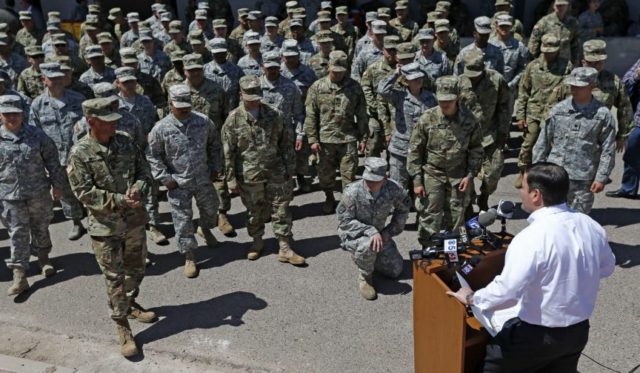PHOENIX (AP) — Arizona was sending 225 of the state’s National Guard members to the border with Mexico Monday and pledged to deploy another 113 on Tuesday to support President Donald Trump’s plan to use the military to help fight illegal immigration and drug trafficking.
The Arizona troops were being sent after Texas announced Friday it would send 250 National Guard members and helicopters took the first of them to the border.
Trump said last week he wants to send 2,000 to 4,000 National Guard members to the southwestern border.
Arizona Gov. Doug Ducey told a group of soldiers preparing to deploy from a Phoenix military base that their “mission is about providing manpower and resources to support federal, state, county, tribal and local law enforcement agencies in stopping the flow of criminals, narcotics, weapons and ammunition that is being trafficked into our state.”
Ducey initially said Arizona would send more troops on Tuesday but did not specify how many. The state’s National Guard in a statement later that 113 members would follow the initial deployment of 225.
The Republican Ducey told reporters later that the deployments are needed to stop a surge of border crossings since March and accused the U.S. government of previously ignoring the border “for nearly a decade.”
Texas officials showed images over the weekend of guard members arriving at the border but the state’s National Guard did not respond to queries Monday about how many of the 250 troops it said would be at the border soon had arrived.
New Mexico’s Republican governor, Susana Martinez, has said her state would take part in the operation but no announcement has been made on deployment. California Gov. Jerry Brown, a Democrat, has not said if his state’s Guard members will participate.
Ducey denied that his decision to send guard members to the border was politically motivated.
“I don’t think this is a partisan issue or an identity issue,” Ducey said. “You show me somebody who is for drug cartels or human trafficking or this ammunition that’s coming over a wide-open and unprotected border here.”
Trump has said he wants to use the military at the border until progress is made on his proposed border wall, which has mostly stalled in Congress.
Defense Secretary James Mattis last Friday approved paying for up to 4,000 National Guard personnel from the Pentagon budget through the end of September.
A Defense Department memo said the National Guard members will not perform law enforcement functions or “interact with migrants or other persons detained” without Mattis’s approval.
It said “arming will be limited to circumstances that might require self-defense” but did not further define that.
The head of the U.S. Border Patrol sector that includes part of West Texas and all of New Mexico said Monday he met with leaders of the New Mexico National Guard to begin discussions about what will be required and their capabilities.
El Paso Sector Chief Patrol Agent Aaron Hull says those troops are nowhere near deploying yet.
The New Mexico Guard members could help with air support, surveillance and infrastructure repairs, Hull said.
Hull says the troops could help with air support, surveillance and repairs of infrastructure along the border.
Brown’s spokesman, Evan Westrup, said Monday that California is still reviewing Trump’s request for use of the state’s National Guard members.
California National Guard spokesman Lt. Col. Tom Keegan said last week that any request will be “promptly reviewed to determine how best we can assist our federal partners.”
After plunging at the start of Trump’s presidency, the numbers of migrants apprehended at the southwest border have started to rise in line with historical trends.
The Border Patrol said it caught around 50,000 people in March, more than three times the number in March 2017.
That’s erased a decline for which Trump repeatedly took credit.
Border apprehensions still remain well below the numbers when former Presidents George W. Bush and Barack Obama deployed the Guard to the border.
___
Associated Press writers Nomaan Merchant in Houston, Susan Montoya in Albuquerque, New Mexico, and Katherine Ronayne in Sacramento, California contributed to this report.

COMMENTS
Please let us know if you're having issues with commenting.